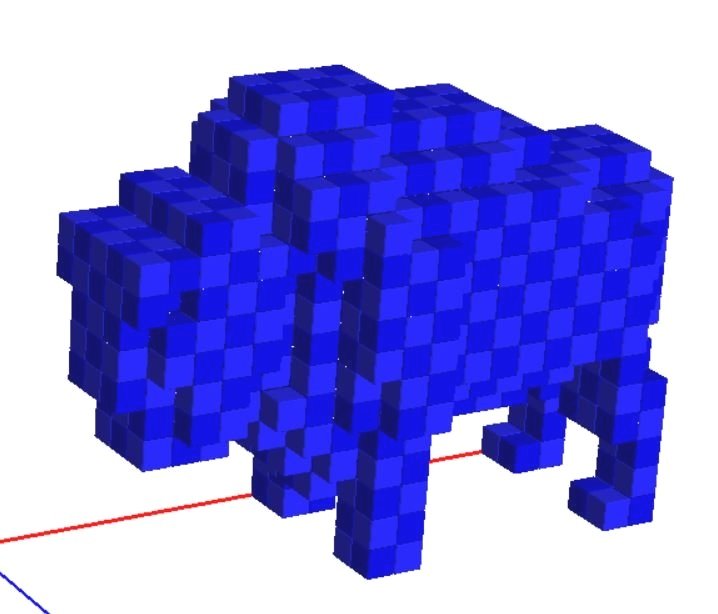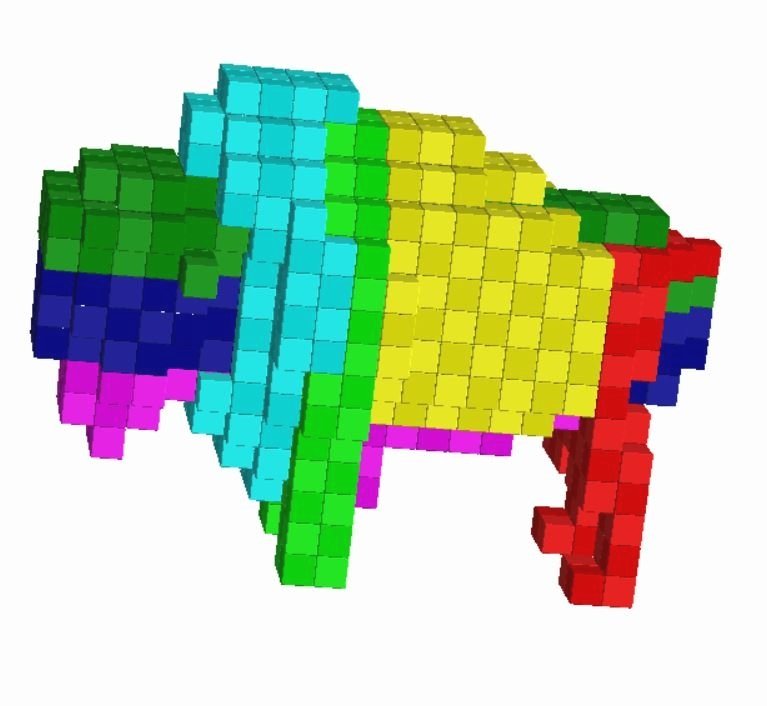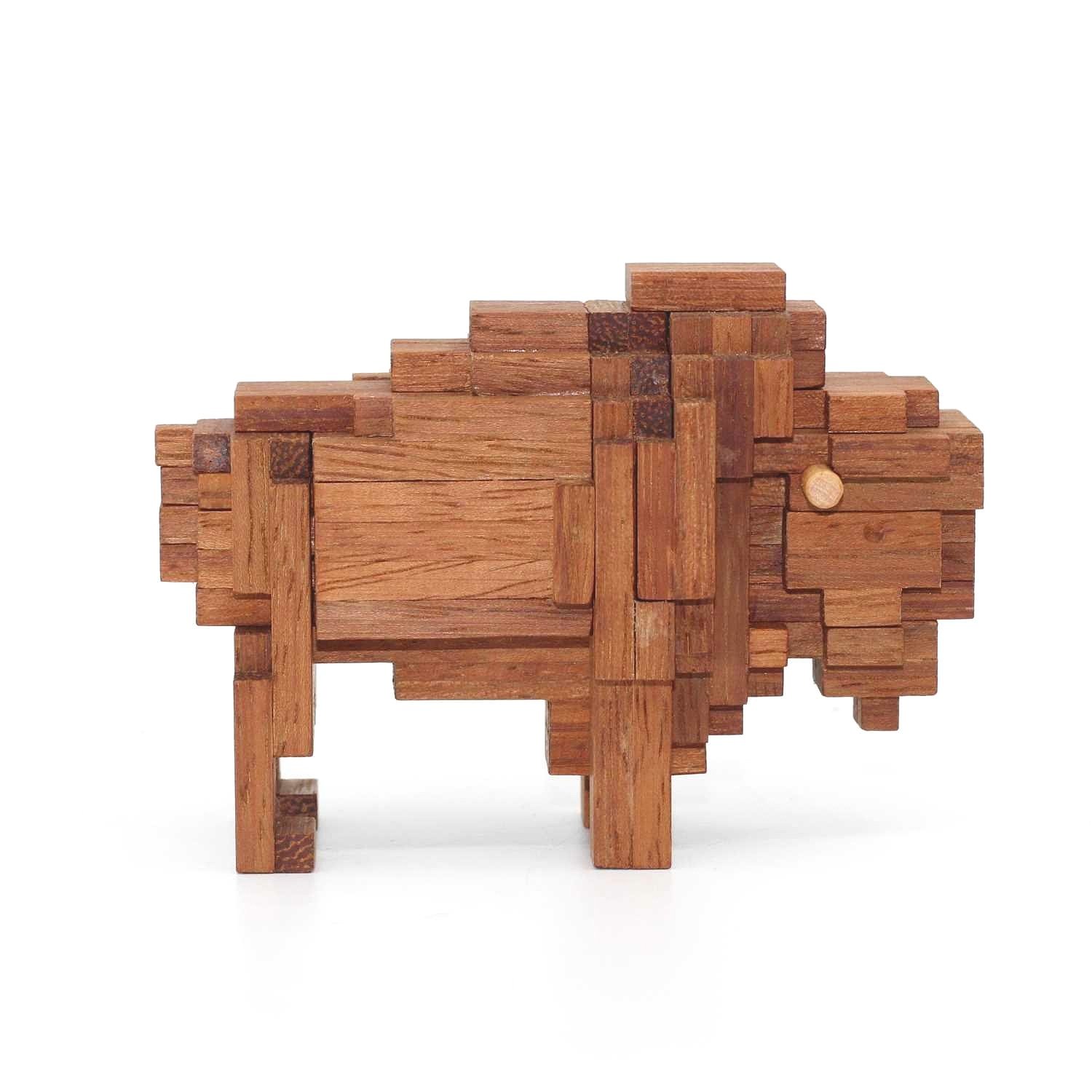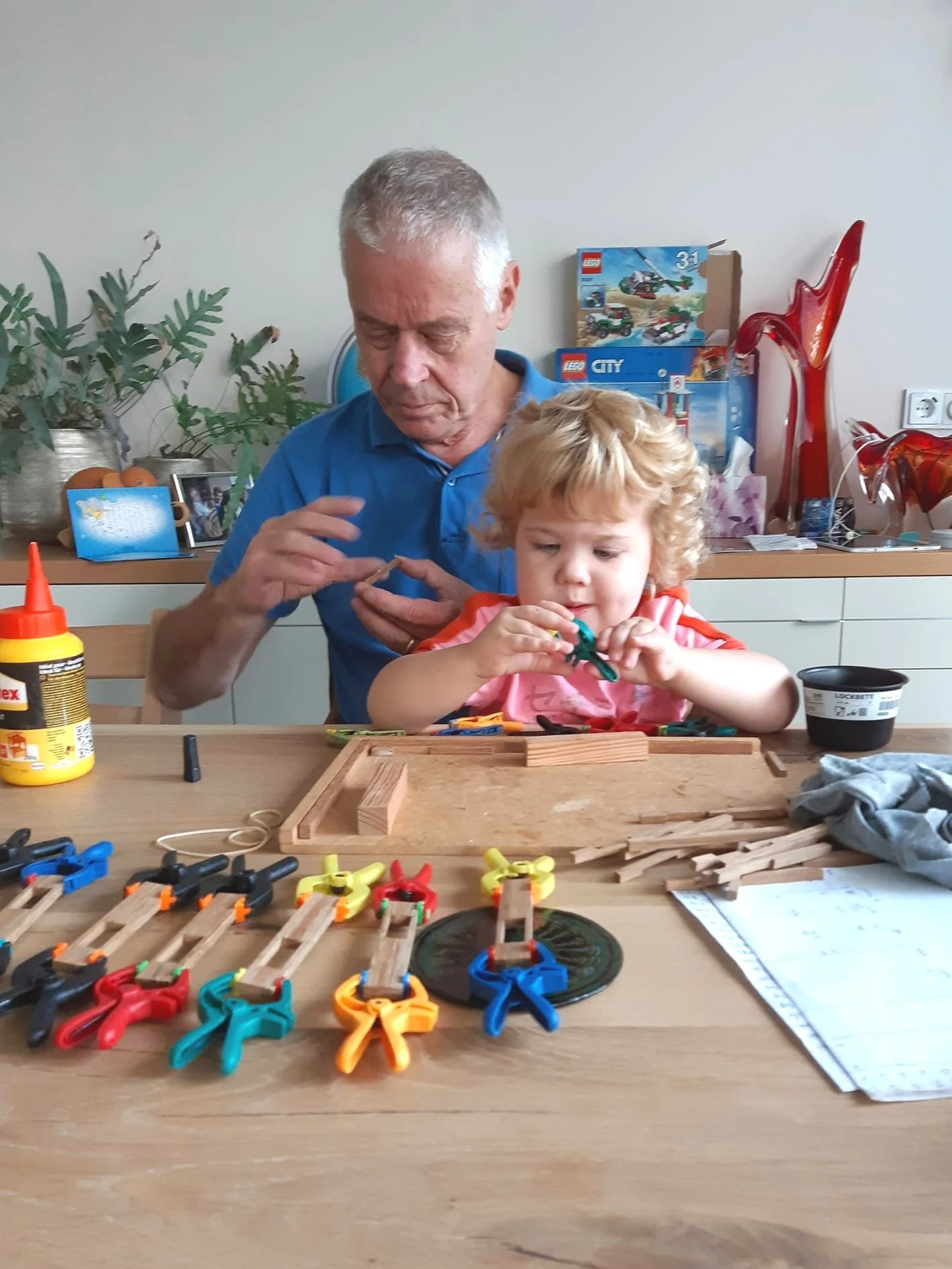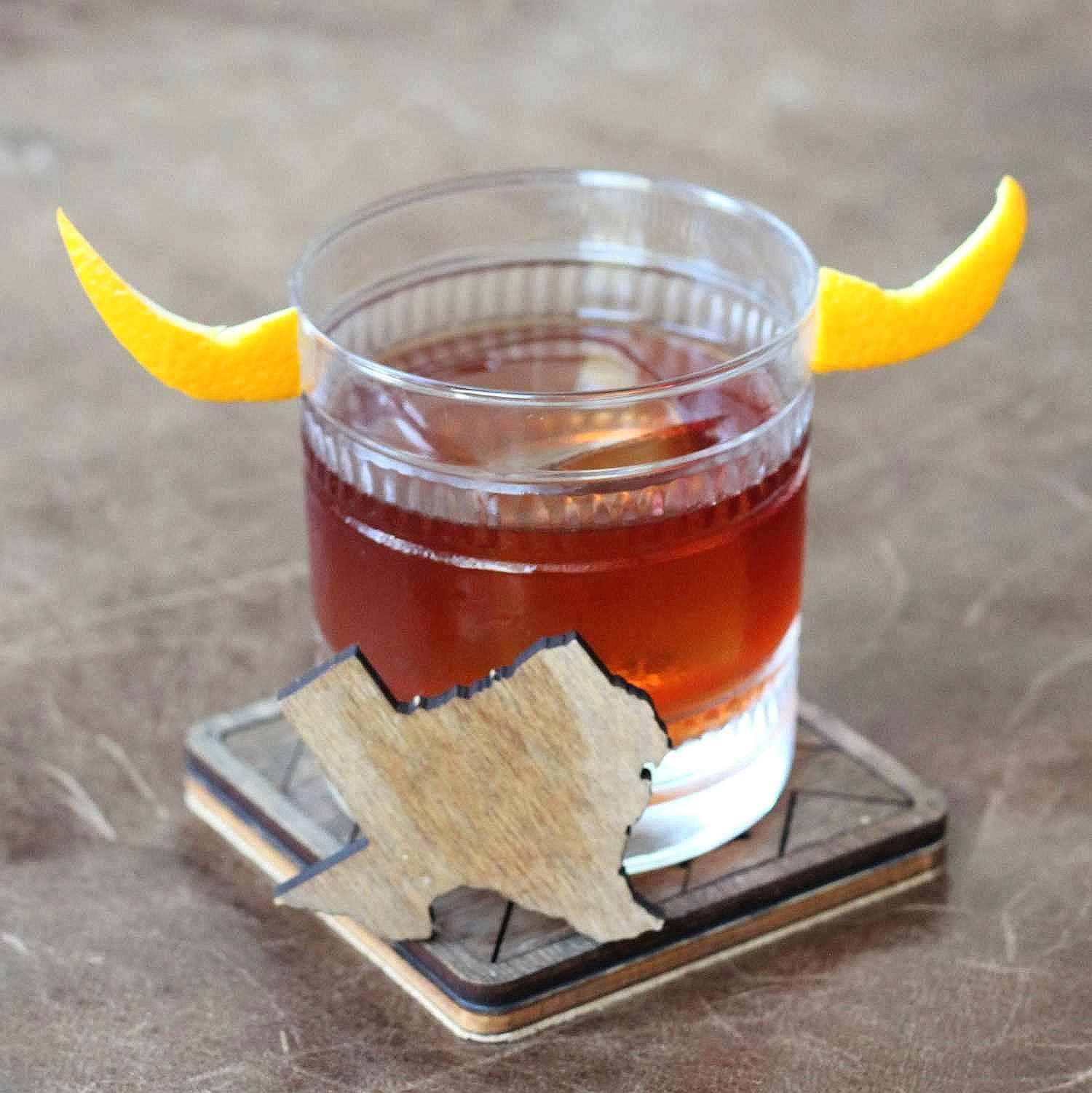Paleolithic Puzzling
Bison Burr
Bison Burr by Jack Krijnen
Jack Krijnen, a mathematician from Einthoven University in the Netherlands, has spent a lifetime with his hobby of both inventing and crafting interlocking puzzles. He has never been as interested in extreme complexity and “difficulty” in his puzzles, as in favoring logic and elegance. So his famous Tipperary burr, which admittedly was spurred by a competitive desire to best designer Goh Pit Khiam’s Burloon in number of moves, and caused him many months of perspiration, would nonetheless not have succeeded had the eventual solution not been so elegantly satisfying.
His Bison Burr may be a long, long way from Tipperary, but also represents another style of puzzle he enjoys creating. Many years ago he designed a whimsical elephant burr for his daughter, which he named Mary’s Pet. Of that design he commented, “it involves more inspiration than perspiration”, and was mostly a crafting challenge once the interlocking sequence had been determined. The inspiration for the Bison arguably started fifteen thousand years ago, in the prehistoric caves of our ancient human ancestors. French cave tour guide and mechanical puzzle enthusiast Gwenn Rigal had a vision to commission an ambitious art project many years ago, which would celebrate the six most important prehistoric cave discoveries in an unusual format – a series of impressive puzzle boxes which would be housed inside a large chest. One of the individual box artists he contacted was Jack Krijnen, who recounts his involvement in the project.
“Gwenn Rigal contacted me in April 2021 and asked me to participate in his Cave Art Chest Project. He wanted an apothecary chest with 6 boxes, all dedicated to a specific cave and the paleolithic cave art in it. The other participants were Michael Toulouzas, Stephan Baumegger, Kelly Snake, Tracy Wood Clemons and Tomasz Gawronski. Nicholas Phillips would make the chest itself. My contribution should have the Tuc d'Audoubert cave as theme. It is located in the south of France. The masterpieces of this cave are two clay bisons, the best preserved examples of clay modellings in the whole European cave art. They are 15,000 years old, and have become iconic. The bisons should have a central place in the SD-box for the project.
The bison of Tuc d’Audoubert
Before saying yes, I gave the box some preliminary thoughts. With my experience as a model railroader I could make the cave from modelling plaster, with water at the entrance, made from toilet paper(!). If I implemented a turntable in the water it would allow the bison(s) to emerge out of the cave. Of course, to make it sequential discovery, every step (including the bisons) should be or should provide a tool for further progress. At the top and back side of the box, there would be enough space left for more actions. The first ideas for the latter slowly started to take shape.
With the bisons as eyecatcher for the SD-box to be, determining their appearance would be a crucial step. I did some research on the web and found a picture of the bisons in the cave. I also found a photo of a real bison. I modelled both options in BurrTools, and discussed them with Gwenn. His preference (and by the way also mine) was the realistic one. Next step for me was to prototype the shape of this bison. If it would look satisfactory, the project would be a go for me.
The prototype was looking great, so I started the design. Knowing that Gwenn was no burr addict ("so please don't give life to a 25.14.5.2.2 monster!"), I kept it simple, and playing with BurrTools I soon determined the parts for the bison. I used the shape I modelled in BT earlier, defined a number of colours, and coloured the voxels in the shape. Having done that I defined the pieces separately in BT; after some small corrections it worked as desired. I also made sure there was a cavity in the bison.
Next came the crafting. I made the bison from square stock, 5 mm wide. For the construction of each piece I again used BT and colours. In total I needed 185 pieces of wood of lengths from 1 to 21 units. I glued them together and sanded the pieces for a smooth operation. With an oil bath as last step I had my first bison! The second bison was made in a similar way, with an even more simple design, but with a twist: the horns-piece has to be removed to open the bison and gain access to the cavity. Nice detail: on special request from Gwenn I gave the first bison hollow, and the second one protruding eyes. Just as in the real cave!
Back to the box: a couple of introductory steps make the turntable turn, and the first bison comes forth. It is secured to the turntable with four magnets. In the cavity inside this bison I placed a club with a hidden magnet. It must be placed on the right spot at the turntable to unlock it. Turn again, and the second bison emerges. It hides two spears, made with a paleolithic look. They are needed to open the compartment on top of the box. And so on. I made it a special challenge for myself to relate all tools and puzzles to the Tuc d'Audoubert cave and the paleolithic time.
I completed the box in August 2021. So the whole process took me 4 months, surprisingly fast. I had little on my hands when I completed the building of The Tippenary Mystery Tours in March 2021, so I could spend most of my spare time on this project.
Jack and Nora hard at work
In the mean time the box and the bisons already attracted attention. Gwenn asked me to make a series of bisons for him to sell or give away; so I made a small batch of 15 copies in the autumn of 2021. Instead of the club I put a small souvenir inside, a piece of wood with two bisons engraved and the text "Tuc d'Audoubert" on the backside. It took me quite some time and glue, but luckily I had assistance! Around the same time Jakub Dvorak (Pelikan puzzles) asked my permission to make a series of the bison. He wanted to stay as close to the original as possible, so my own copy made a trip to the Czech Republic to serve as an example; Jakub also used my picture for a similar souvenir inside the bison. Pelikan made 42 copies. They sold out within the hour...”
Bison are part of American history and lore as well, having roamed the native plains for ages before the arrival of our modern colonizers. These majestic creatures were all but decimated during the nineteenth century in America through a combination of hunting, slaughter and disease. In 1889 just 541 bison survived in North America. Thankfully preservation efforts prevailed and these majestic animals still have a home on the range.
Home on the Range by Michael Madrusan
The origins to the toast of the Bison can be found in the pages of Crosby Gaige’s Cocktail Guide and Ladies’ Companion, 1941. It takes the form of a classic Manhattan, with a bourbon base augmented by sweet vermouth, but adds a touch of orange liqueur to brighten and subtly modify the drink. It’s a lovely variation from the era of light touch elegance in cocktails.
a range of ingredients
The modern cocktail renaissance began around the turn of the twenty first century. Some would argue it coincided with the opening of Milk and Honey, a fiercely particular and unapologetically exclusive bar in New York’s Lower East Side which had no signage and served its first drink on New Year’s Eve, 1999. The bar’s proprietor, Sasha Petraske, was a legend in the industry who prefered simple elegance, fresh and pure ingredients, and old world charm in his drinks. His bar, which famously enforced a set of “rules of etiquette”, went on to spawn many more famous establishments and bartenders who were part of the original team. One of those barmen was Michael Madrusan, now an industry veteran with so many classic bars to his resume. He rediscovered the old recipe to this cocktail and modernized it by swapping the original Dubonet rouge for sweet vermouth, and excellent choice. Sasha Petraske, according to Madrusan, loved the drink so much, he kept it on every bar menu he had a hand in ever after Milk and Honey. Here’s to classic artistry, modern interpretation, celebrating our ties to the past, and the creation of new classics. Cheers!
a range of options
Home on the Range by Michael Madrusan
3 dashes Angostura bitters
¼ oz sweet vermouth (Cocchi Vermouth di Torino recommended)
¼ oz Cointreau
2 oz bourbon
Lemon and orange twists for garnish
The drink should be built right in the glass in this order. Add a large ice cube and stir, then garnish.
Special thanks to Jack Krijnen for his story, photos, video and drawings
Tuc d’Audoubert puzzle box and bisons by Jack Krijnen






